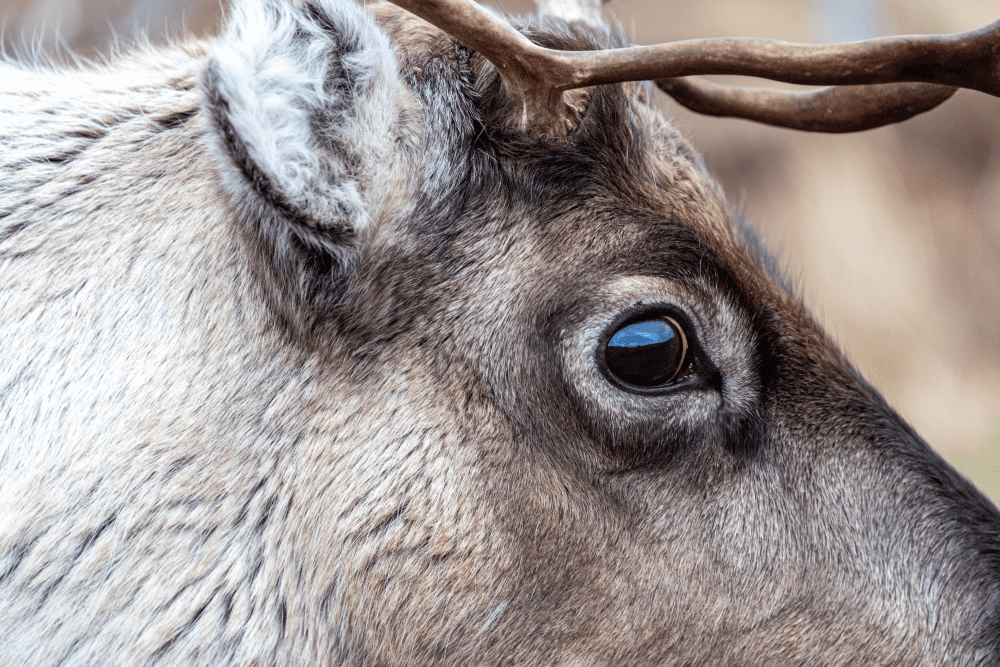You might have seen a cool post on Reddit that appears to show the dramatic transformation of reindeer eyes from golden brown in the summer to White Walker blue in the winter. Unfortunately, this photo is fake as the vibrant blue eye is actually an edited version of a real image on Alamy. However, there is some truth to the winter wonderland makeover.
Reindeer are the only animals known to change eye color in the winter, but the effect isn’t so outwardly obvious. Once you see what’s going on inside the eye, however, it really is quite a spectacular change. One that was discovered when neuroscientist Glen Jeffery found himself – without really asking for it – in possession of a big ol’ bag of reindeer eyes.
In fairness, studying animal vision at the University College London, UK, meant Jeffery had good reason to end up with the creepy accessory. Colleagues were eager to understand how reindeer tolerated the extreme change in light conditions annually experienced, so turned to Jeffery with a bag-load of googlies.
What felt like an imposition would turn out to be quite the find, however, as reindeer eyes harvested from animals killed in the summer and others killed in the winter were found to contain more wonder than a Kinder Surprise.
“I thought it was a dumb idea,” Jeffery, who figured the adaptation lay in the animals’ neurological function rather than their physical eyes, told National Geographic. “I opened them up and went: Jesus Christ! Hang on. They’re a different colour.”
The color change is subtle, but you can see it in living animals. Image credit: James McKay / Shutterstock.com
The transformation takes place in the tapetum lucidum or “cat’s eye” which sits behind the retina. It acts a bit like a mirror bouncing light that comes through the retina back onto it so that the eye basically gets two shots at detecting photons and making sense of the environment.
Most mammals have golden cat’s eyes, which is true too of reindeer in the summer but come winter they turn blue. Why? During the long winter, reindeer’s eyes are permanently dilated to try and see as much as possible in the dark conditions of the Arctic circle where some parts get little sunlight for up to six months of the year. This increases pressure in the eye, changing how tightly packed the collagen is in the tapetum lucidum layer.
As they bunch together under the eye’s increasing pressure, it changes how they reflect light moving from yellow wavelengths to blue. And, hey presto, you have yourself a blue cat’s eye. Jeffery and colleagues made the discovery back in 2013, but accounts from the time would indicate the results left a lasting impression.
“I opened the eyes up on my lab bench and almost fell off my chair,” Jeffery told Live Science. “The differences were so dramatic, and I knew no one had ever seen anything like that before… We have some evidence that the blue reflection in winter amplifies ultraviolet light, while in summer it suppresses it.”
New research in 2022 further investigated the phenomenon, finding that the color shift was linked to the uniqueness of twilight which is different from day or night. Twilight also happens to be when the reindeer feed and their arch nemeses – wolves – hunt.
Twilight is different from day and night, and being able to see in it is a matter of life and death for reindeer. Image credit: Andrei Stepanov / Shutterstock.com
As the Sun dips below the horizon, its light is filtered by Earth’s ozone layer, absorbing almost all light except for blue light. This filtered light is all Arctic animals have to go on for around a third of the day during winter, so it figures that they would evolve adaptations to keep their vision clear during these pivotal hours of the day.
The study looked at the eyes of reindeer that died in summer against those that died in winter and found that the seasonal change that makes them turn blue is likely brought on by a change in ocular pressure. This pressure is changed by an increase of fluid passing into its tapetum, and our understanding of it could give rise to a host of novel color-changing technologies.
While the color-shifting eyes of reindeer might not turn them White Walker blue to the human eye, it does give these animals an advantage in the dark. Our advice? Winter is coming, stay on Rudolf’s good side.
Now you know all about reindeer eyes, come learn about the legend of the Christmas Spider.
Source Link: How A Big Bag Of Reindeer Eyes Revealed That They Turn Blue In Winter
